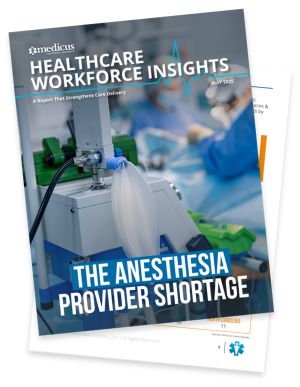
The demand for anesthesia services continues to rise, but the supply of trained providers is not keeping pace. National workforce projections show a measurable and widening gap that is already affecting staffing stability in health systems across the United States.
To access the complete Anesthesia Provider Shortage White Paper, complete the short form below.
View the Full Anesthesia Provider Shortage White Paper Here:

View the Full Anesthesia Provider Shortage White Paper Here:
Anesthesia by the Numbers: Workforce & Job Growth Projections
The Anesthesiologist Workforce:
There are approximately 52,300 anesthesiologists within the United States; however, workforce projections indicate a growing gap in supply. According to the Health Resources & Services Administration (HRSA), the U.S. could see a shortage of 8,450 anesthesiologists by 2037.

The Certified Registered Nurse Anesthetists (CRNA) Workforce:
There are an estimated 67,700 CRNAs in the U.S., with approximately 200 for every 100,000 people.
%20Workforce.png?width=800&height=433&name=The%20Certified%20Registered%20Nurse%20Anesthetists%20(CRNA)%20Workforce.png)
The Certified Anesthesiologist Assistant (CAA) Workforce:
In response to growing anesthesiologist shortages, CAAs are emerging as a valuable staffing resource in health systems, leveraging supervised, team-based anesthesia staffing models.
%20Workforce.png?width=800&height=433&name=The%20Certified%20Anesthesiologist%20Assistant%20(CAA)%20Workforce.png)
There are roughly 4,000 active CAAs working in anesthesia care team models in health systems across the United States.
Locum Tenens Anesthesia: A Look at the Interim Anesthesia Workforce
Out of over 124,000 active anesthesia providers, including anesthesiologists, CRNAs, and CAAs, over 8,000 have worked locum tenens either alongside their permanent job or as a stand-alone career, with anesthesia among the most searched locum tenens specialty.

Key Drivers: Factors Behind the Anesthesia Provider Shortage
The Aging Population & Workforce: A Dual Challenge for Anesthesia Services
The aging population is intensifying the need for anesthesia providers, as older adults often require more procedures involving monitored sedation or general anesthesia.

Compounding this rising demand, the anesthesia workforce is also aging, with a large share of anesthesiologists and CRNAs expected to retire within the next decade.
Anesthesiologist Workforce Demographics:
.png?width=400&height=127&name=Anesthesiologist%20Workforce%20Demographics%20(1).png)
.png?width=400&height=117&name=Anesthesiologist%20Workforce%20Demographics%20(2).png)
These numbers suggest that by 2030, a significant portion of anesthesiologists could retire or semi-retire, according to the Journal of Medicine, Surgery, and Public Health.
CRNA Workforce Demographics:
.png?width=400&height=127&name=CRNA%20Workforce%20Demographics%20(1).png)
.png?width=400&height=117&name=CRNA%20Workforce%20Demographics%20(2).png)
This growing imbalance between retiring anesthesia providers and increasing patient volumes could further strain healthcare systems, prolong wait times, and limit patient access to care in the years to come.
Limited Training: Supply & Demand Mismatch
The influx of new anesthesia providers remains insufficient to offset retirements or align with the rising need for anesthesia services, a gap largely driven by limited training capacity.
Anesthesiologist Training Insights:
Anesthesiology residency positions have increased by approximately 24% since 2021, according to the National Resident Matching Program (NRMP). Yet, current growth rates fall short of meeting projected workforce requirements and the expanding volume of anesthesia cases.

CRNA Training Insights:
Although 2,400 CRNAs graduate annually, according to the AANA, training capacity remains insufficient to meet rising patient demand and address the growing anesthesia workforce shortage.
.png?width=300&height=185&name=CRNA%20Training%20Insights%20(3).png)
.png?width=300&height=178&name=CRNA%20Training%20Insights%20(1).png)
.png?width=300&height=151&name=CRNA%20Training%20Insights%20(2).png)
The mismatch between applicants and available training slots highlights a critical bottleneck in the field of anesthesia. Expanding residency and training programs, increasing funding, and exploring alternative training pathways will be vital to closing the workforce gap.
Financial Strain: The Impact of Limited Anesthesia Access
The OR is one of the more challenging sectors within a health system to keep adequately staffed and optimally utilized. Healthcare leaders continue to face challenges in the recruitment and retention of surgeons, anesthesia providers, and OR staff.
.png?width=360&height=100&name=The%20Financial%20Strain%20of%20Limited%20Anesthesia%20Access%20(1).png)
.png?width=441&height=100&name=The%20Financial%20Strain%20of%20Limited%20Anesthesia%20Access%20(2).png)
Even the temporary loss of a single anesthesiologist can disrupt case volumes, delay procedures, and jeopardize both revenue and care continuity.
Actionable Strategies: Overcoming the Anesthesia Provider Shortage
Adopt an Anesthesia Care Team (ACT) Model: Optimizing Workforce Efficiency
Relying solely on an MD-only anesthesia staffing model presents limitations due to the growing shortage of anesthesiologists. Adopting an anesthesia care team model composed of anesthesiologists, CRNAs, and CAAs is a cost-effective way for health systems to optimize efficiency while maintaining access to care amid increasing patient demand and anesthesiologist shortages.
%20Model%20-%20Optimizing%20Workforce%20Efficiency.png?width=600&height=444&name=Adopt%20an%20Anesthesia%20Care%20Team%20(ACT)%20Model%20-%20Optimizing%20Workforce%20Efficiency.png)
Leverage Locum Tenens Anesthesia Providers: Bridging Workforce Gaps
Locum tenens anesthesiologists, CRNAs, and AAs are a vital strategy for maintaining consistent access to anesthesia care, particularly in rural areas.

Partnering with a trusted locum tenens staffing agency like Medicus ensures reliable coverage and support. We manage the complexities of locum tenens staffing, providing the necessary resources and expertise to maintain continuity of care while minimizing the strain on your permanent team.
Frequently Asked Questions About the Anesthesia Workforce
How Many Anesthesiologists Are in the United States?
There are approximately 52,300 anesthesiologists in the U.S.
How Many Anesthesiologists Work Locum Tenens in the U.S.?
According to Medicus' proprietary data, as of May 2025, approximately 5,300 anesthesiologists have engaged in locum tenens work, either in tandem with their permanent roles or as a standalone career.
What States Have the Fewest Anesthesiologists Per Capita (100,00)?
The states with the fewest anesthesiologists per capita include Idaho, South Dakota, Mississippi, and North Carolina.
What States have the Fewest CRNAs Per Capita (100,000)?
Utah, Hawaii, Nevada, and California are the states with the lowest number of CRNAs.
How Many States Can CRNAs Practice Independently In?
CRNAs' scope of practice varies by state; however, according to the National Council of State Boards of Nursing (NCSBN), 32 states allow CRNAs to practice independently, as well as Washington, D.C.
How Many CRNAs Work Locum Tenens in the U.S.?
Based on Medicus' proprietary data, as of May 2025, roughly 2,800 CRNAs have worked locum tenens, either in tandem with their permanent roles or as a standalone career.


